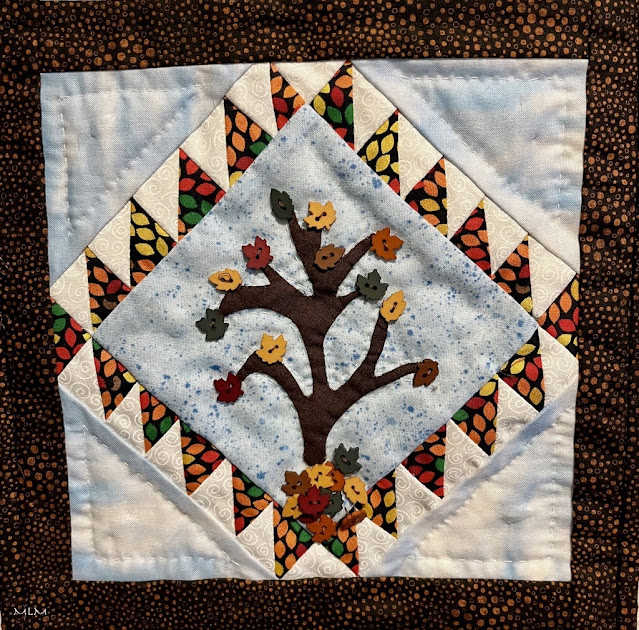Warping in progress from a few weeks ago. That's nearly 600 warp strings sleyed through the reed and heddles, and ready to be wound onto the back beam.
After several months of planning and several weeks of preparations for this Mountain Cucumber / Governor's Garden coverlet project, the loom is warped and nearly ready to weave again! Last weekend as I was winding on the warp, no less than 10 strings popped and broke under the stress. Maybe I had some crossed threads in that section? I guess that's not bad with 600 strings! It took a good part of a day to repair those 10 broken strings. Dealing with a 15-yard warp requires some extra fussing not necessary in a shorter warp. Although I ran extra warp strings for repairs, it turns out they are difficult to manage being so long. I was having a hard time pulling 1 string for repairs without it tangling. I found it was easier to run the repair stings individually 5 yards at a time, and wind them onto a pill bottle to keep it from tangling. Repairs are done now!

Pill bottles on the back have loose change in them to weight down the repair warp strings. The pop tops keep the strings from unwinding.
Also tied up the treadles this weekend. That part was relatively easy!

The next step was to set up the treadle beads. This pattern requires about 300 treadling changes per 1 pattern repeat. With so many steps, I needed additional rows to hold the treadle beads. Look for a separate post on that topic.
________________
I've been referring to this epic coverlet project as The Odyssey, because it's a huge undertaking, and will take a while for me to finish it. And I'm learning a lot as I go. Other than rugs, this may be the first time I'm not following a kit or set pattern, so I've had to draw on 10+ years of weaving to move ahead ...

Repair Heddles hanging off the back of the loom.
Angel Wings (those wooden dowels that separate the threads) allow for more even tension while winding on.
PHOTO REPAIR HEDDLE
There was just 1 heddle I needed to
re-thread. In the plain weave test, I could see that I'd missed one --
Actually, I'd put it through a heddle on shaft 4, when it should have
been shaft 3. Easy enough to fix! I made a temporary string heddle in
the right place on shaft 3; pulled the respective warp thread,
re-threaded it through the new repair heddle and tied it back onto the
front beam. Voi la! Back in business!

It feels sooo good to be weaving again! It makes the planning and set-up all worth the time and effort to get to the fun part. It is magic to see the pattern emerge on the cloth!
Testing and Experimenting - Starting to weave
I calculated some extra warp for testing and experimenting. I need to figure out
- What shuttles to use
- What threads for tabby
- How much space a block will take, so I can make sure I'm consistent -- The 4 panels need to match up when I sew them together.

For the initial test, I used the 10/2 cotton yarn, same as the warp
strings. Although it's a relatively fine string, it seemed to weave a
not so fine cloth. The blue pattern threads should be closer together
so they read as color blocks. That can be fixed by using the finer 20/2 cotton thread for tabby, and by beating a little harder.

Shuttles
Although I love the Schacht kayak shuttles, they were too light for this project. I needed something with more weight and heft to press down the threads in the shed--They were a little sticky when I started weaving. he 1980s shuttle also was not ideal -- the wire requires a pair of pliers to remove and change a bobbin, which is too much fuss and bother. The obvious choice for the blue pattern thread was the maple Hockett shuttle. It has good weight for this project (The similar sized Bubinga shuttle in the same shape is too heavy). The Hockett shuttle has a nice wide flat base that slides over the threads. And I can wind quite a bit of yarn on the bobbins.
For the tabby shuttle, I tried using my lovely little commissioned apple wood shuttle. It has a nice weight and width, but it was too short and it was hard to throw all the way across the width of this fabric. Again, my beloved Schacht shuttles were too light for this application.
 Shuttle Winners for this project:
Shuttle Winners for this project:
Jim Hocket Birds Eye Maple Shuttle (top)
Jim Hockett Bubinga Double Bobbin Shuttle (bottom)
So I opted for the double-bobbin Bubinga Hockett shuttle, even though I will only be using 1 bobbin at a time. The advantage of this shuttle is that it's about the same length as the larger maple Hockett shuttle I'm using for the blue pattern thread, which makes it easier to throw through the shed without it getting stuck in the middle. And it's a little narrower, which is a nice mental note because it carries the thinner tabby thread.
To be continued ...






































